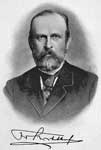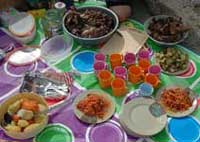|
 
|
From the Editor's Desktop:
Richthofen's "Silk Roads": Toward the Archaeology of a Concept
|
1 |
| On the 130th anniversary of Ferdinand von Richthofen's
publication of the term "The Silk Road" (Seidenstrasse),
this article examines what he actually meant, which is both
narrower and broader than what many subsequently have assumed. |
|
| |
| Georgia: A Culinary Crossroads,
by Darra Goldstein |
11 |
| The culinary history of Georgia is especially rich and
varied, thanks to the country's natural abundance and its location
at a crossroads of cultural and political interaction in western Asia.
Georgian food is an important component of national identity and is
celebrated in literature and the arts. The article includes several
wonderful recipes. |
| |
| Food, Medicine and the Silk
Roads: The Mongol-era Exchanges, by Paul D. Buell |
22 |
| The Mongol Empire made possible an unprecedented level
of cultural exchange across Eurasia. Among the to date least well
known aspects of this is culinary exchange and connection with the
spread of medical knowledge. Texts preserved in China document vividly
the Yuan-era acquisition of information from the Islamic Middle East.
The court cuisine of the Mongol rulers drew upon a wide range of spices
and recipes; there is good reason to believe that the famous Blue
and White porcelain became a sought-after commodity because it was
ideally suited to the new imperial cuisine. |
| |
 
|
In Search of Mongolian
Barbecue, |
| by Debra McCown |
36 |
| Today's enthusiasts for barbecue will travel far
to enjoy its delights, as did the author in discovering what
real Mongolian barbecue (hodog and boodog) is.
The labor-intensive process of preparing this traditional food
reveals a great deal about Mongolian culture today. |
|
| |
| Investigation of a Xiongnu
Royal Complex in the Tsaraam Valley. Part 2: The Inventory of Barrow
No. 7 and the Chronology of the Site, by Sergei S. Miniaev
and Lidiia M. Sakharovskaia |
44 |
| This article expands on the report published previously
in The Silk Road concerning the excavation of a major elite tomb in
Buriatiia, just north of the border with Mongolia. Among the finds
were a Han bronze mirror, which had been ritually broken into several
pieces, a Chinese chariot, largely painted in lacquer, and several
"dolls" which each were provided with a varied burial inventory. The
article concludes with a summary of the evidence about the date of
the burial complex. |
| |
| A Chinese Inscription from
a Xiongnu Elite Barrow in the Tsaraam Cemetery, by Michèle
Pirazzoli-t'Serstevens |
56 |
| One of the finds in Tsaraam Barrow No. 7 was the remains
of a lacquered box with a Chinese inscription. Its text suggests that
the box had been made in the Imperial workshop in Chang'an and probably
should be dated to the very end of the former Han period. |
| |
 
|
On Ancient Tracks in
Eastern Anatolia, |
| by Frank Harold, with photographs by Ruth Harold |
59 |
| The rich history of eastern Anatolia often escapes
the tourist gaze, since the region is somewhat off the beaten
track. Yet the network of routes and the striking evidence of
commercial centers and the region's important political and
cultural traditions merit attention. |
|
| |
| Dzchingis Khan und seine Erben
(Chingis Khan and His Legacy), |
| reviewed by Florian Schwarz |
66 |
| This impressive exhibit catalogue covers a lot of Mongolia's
history but has a particular focus on the new discoveries about the
urban history of the Mongol empire. |
| |
| Conference Report: Marking
the Centenary of Dunhuang, by Daniel Waugh |
68 |
| A report on two conferences held in London in May 2007
to mark the centenary of Aurel Stein's discovery of the riches in
Mogao Cave No. 17. The conferences offered a broad range on papers
on the current status of "Dunhuang studies" and on the projects which
now are making the material available and preserving it for future
generations. |
| |
| Upcoming programs |
73 |
, Vol. 5, No. 1 (Summer 2007),


